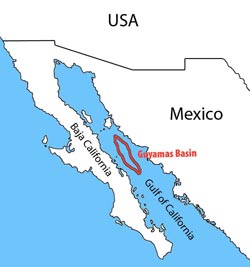Strange diet for methane consuming microorganisms

Where the samples were taken: The Guaymas Basin on the West coast of Mexico.<br><br>Rita Dunker, MPI BRemen<br>
Methane is formed under the absence of oxygen by natural biological and physical processes, e.g. in the sea floor. It is a much powerful green house gas than carbon dioxide.
Thanks to the activity of microorganisms this gas is inactivated, before it reaches the atmosphere and unfolds its harmful effects on Earth´s climate. Researchers from Bremen have proven that these microorganisms are quite picky about their diet. Now they have published their results in the Proceedings of the National Academy of Sciences (PNAS).
Carbon can be the basic structural element…
All life on Earth is based on carbon and its compounds. Cell components of all creatures contain carbon. The cell can take up this basic structural element via organic matter, or the cell build up its own organic matter from scratch, i.e. carbon dioxide. Researchers termed the first cells heterotrophs and the latter autotrophs. All plants, many bacteria and archaea are autotrophs, whereas all animals, including humans, are heterotrophs. The autotrophs form the basis for the life of the heterotrophs and all higher life by taking up inorganic carbon to form organic material.
…and can be the energy source
To keep the cellular systems running all cells need fuel. Methane can be such a fuel. When studying the methane consuming microbes discovered by Bremen scientists more than ten years ago it was assumed that they take the methane for filling up their energy tanks and using it as a carbon source, i.e, they were thought to be heterotrophs.
Now scientists from MARUM and the Max Planck Institute for Marine Microbiology show in their PNAS research paper that this is surprisingly not the case and the methane derived carbon is not used as a carbon source. “Our growth studies clearly show that the labeled carbon in the methane never showed up directly in the cell material, but experiments with labeled carbon from carbon dioxide did. It was quite surprising, ” said PNAS author Matthias Kellermann. The archaea in the consortia behave like it is expected for chemoautotrophs.
“Archaea and the sulfate reducing bacteria are living close together in consortia, which are growing extremely slow. And only in the newly synthesized cell material we could find the answer for the question, from where the carbon originates,” adds Kai-Uwe Hinrichs, leader of the organic geochemistry group at MARUM.
Co-author Gunter Wegener from the Max Planck Institute concludes: ”With our new knowledge we can optimize our studies about the inactivation of methane in nature. Our surprising results tell us that we still know little details of this globally important process.”
Samples were retrieved from the Guaymas Basin on the West coast of Mexico from a depth of more the 2000 meters using the US diving submersible Alvin .
Manfred Schlösser
Further informations/ photo material/Interviews:
Dr. Manfred Schloesser, +49 421 2028704, mschloes mpi-bremen.de
Dr. Rita Dunker, +49 421 2028856, rdunker mpi-bremen.de
Albert Gerdes, +49 421 21865540, agerdesmarum.de
Institutions
Max Planck Institute for Marine Microbiology, Bremen
MARUM – Center for Marine environmental Research at the University of Bremen
Original article
Autotrophy as a predominant mode of carbon fixation in anaerobic methane-oxidizing microbial communities
Matthias Y. Kellermann, Gunter Wegener, Marcus Elvert, Marcos Yukio Yoshinaga, Yu-Shih Lin,
Thomas Holler, Xavier Prieto Mollar, Katrin Knittel, and Kai-Uwe Hinrichs
PNAS doi/10.1073/pnas.1208795109
Media Contact
All latest news from the category: Life Sciences and Chemistry
Articles and reports from the Life Sciences and chemistry area deal with applied and basic research into modern biology, chemistry and human medicine.
Valuable information can be found on a range of life sciences fields including bacteriology, biochemistry, bionics, bioinformatics, biophysics, biotechnology, genetics, geobotany, human biology, marine biology, microbiology, molecular biology, cellular biology, zoology, bioinorganic chemistry, microchemistry and environmental chemistry.
Newest articles

Pinpointing hydrogen isotopes in titanium hydride nanofilms
Although it is the smallest and lightest atom, hydrogen can have a big impact by infiltrating other materials and affecting their properties, such as superconductivity and metal-insulator-transitions. Now, researchers from…

A new way of entangling light and sound
For a wide variety of emerging quantum technologies, such as secure quantum communications and quantum computing, quantum entanglement is a prerequisite. Scientists at the Max-Planck-Institute for the Science of Light…

Telescope for NASA’s Roman Mission complete, delivered to Goddard
NASA’s Nancy Grace Roman Space Telescope is one giant step closer to unlocking the mysteries of the universe. The mission has now received its final major delivery: the Optical Telescope…



